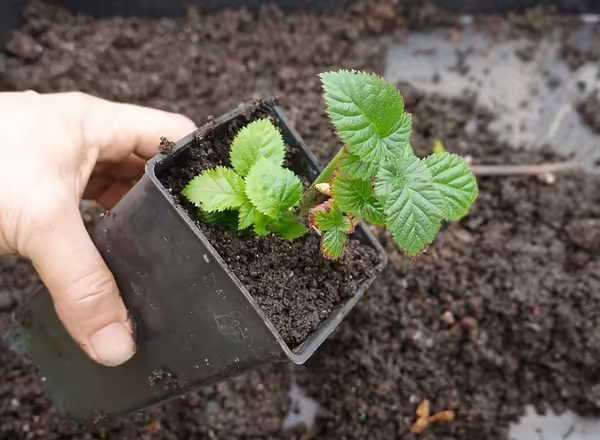
Blackberries are best planted in early spring, using the same care as when planting raspberries. Spacing will depend on the trellis and training system to be used. Most erect blackberry cultivars can be grown without physical supports and are spaced two to four feet apart in rows eight to ten feet apart. Semi-erect and trailing blackberries are planted eight to ten feet apart in rows eight to ten feet apart.

Establish your planting from virus-indexed (certified) plants. Some nurseries can supply tissue culture-derived plants. Tissue culture-derived plants grow more vigorously and become established more quickly than conventionally propagated plants. Tissue culture-derived plants are supplied in three-inch root plugs. When these small plugs are planted, the roots should be barely covered with soil, whereas conventionally propagated plants are set at the same depth as they were when growing in the nursery. The tops of conventionally propagated plants should be cut back to six inches; tissue culture-derived plants need no pruning at this time. Cultivation, mulching, and fertilizer are the same as for raspberries.

Most of the semi-erect and trailing thornless blackberry cultivars are not very winter hardy and are suggested only for southern Illinois. However, with special protection, they can be grown in northern areas, though some winter injury should be expected even then. After they become dormant in the fall, the canes are protected by removing them from the trellis support and completely covering them with soil or straw. Any exposed canes can be damaged by cold air. When the danger of severe cold is past in the spring, uncover the canes, remove broken or dead canes, dormant-prune the other canes, and tie the remaining canes to the support.
Sterility in some blackberry cultivars has been a problem. Affected plants generally grow vigorously and bloom profusely, but set only a few malformed berries. If such plants occur in your garden, they should be destroyed immediately—roots as well as stems.
|
Blackberry Cultivar |
Harvest Season |
Region of Adaptation* |
Notes |
|
|
Thornless |
|
|
|
|
|
Hull Thornless |
late summer |
S |
large fruit, good flavor, not very winter-hardy; plants are semi-erect and need to be trellised |
|
| Chester Thornless | late summer, harvest can last up to 6 weeks | C, S | large, round fruit; fruit is firm and could be transported to local markets without leaking; plants are semi-erect and need to be trellised | |
|
Triple Crown |
mid-summer; earlier than Chester |
S |
newest semi-erect thornless; suitable for trial only |
|
| Arapaho | July | S | erect, thornless, suitable for southern Illinois | |
|
Thorny
|
|
|
|
|
|
Choctaw |
very early |
S |
good flavor, erect growth habit |
|
|
Cheyenne |
|
S |
good flavor, erect growth habit |
|
|
Shawnee |
|
S |
very large fruits, good flavor, erect growth habit |
|
| Illini Hardy | long harvest season | N, C, S | dependable moderate production of good quality fruits |
- *N = adapted to region north of Interstate 80,
- *C = adapted to region between Interstate 80 and Interstate 70,
- *S = adapted to region south of Interstate 70